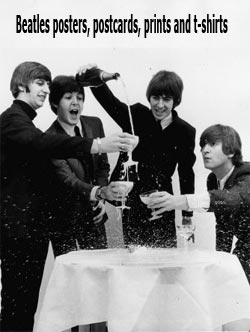The simplistic design of The Beatles' "white album" sleeve: was it really a work of art? Or was it Richard Hamilton plagiarising himself? Perhaps he thought the pay wasn't much, so he didn't want to put a lot of effort into it. Like, "Here's a poster, and you get the cover for free".
BEATLES AND WHITE ALBUM DESIGN
Written and researched by Kevin BradfordIn what can be now seen as a trilogy is a transformation of The Beatles from pop stars to pop artists beginning with Revolver, Sgt Pepper's Lonely Hearts Club Band and The White Album.
 |
| Pepper was the Beatles in an art gallery. "The white album" was the collection of the art. |
It is no coincidence that McCartney had befriended Robert Fraser at exactly this time. Fraser and his gallery was the hot spot for Paul to be introduced to Peter Blake, Jann Haworth and Richard Hamilton. It was Fraser's suggestion that The Beatles hire real artists to make their album covers. One could infer that he considered Voormann's "Revolver" cover to not be done of a "real artist" or that he hoped to gain a contract with his own roster of "real artists" that he also represented.
 |
| Revolver, designed by Klaus Voormann - not considered as a "real artist"? |
It was through Fraser that Paul bought his Magritte art and was the impetus for the Apple label art. Both the art for the Sgt. Pepper cover as well as the "White Album" only got the artists £200 British Pounds for each of the designs. It can be argued it was a measly sum and Blake has made issue about that since.
This reasoning as to why the White Album was a simplistic white cover has been discussed many times over the years. The reasons have been given as:
1. To create a numbered edition like art
2. It was a response to Pepper and psychedelia
3. They wanted to not be judged by the cover but as artists etc.
Hamilton said it best without saying it in one of his last interviews, "It should be treated like a very small edition publication of poems or something!" What people don't realise is that he literally did just that.
From 1960 to 1966, Hamilton produced a series of monographs for the William and Noma Copley Foundation. The series covered René Magritte, Thomas Albert Sills, James Metcalf, Serge Charchoune, Jacques Herold, Hans Bellmer, Richard Lindner, Bernard Pfriem, Eduardo Paolozzi and Diter Rot.
 |
| Magritte was the first artist in the series of monographs. |
 |
| Hamilton's design for Bernard Pfriem |
part of the Sgt. Pepper character background and Apple art influence.
 |
| Design for Serge Charcoune |
 |
| Copley (right) and Magritte |
 |
| The term album comes from latin from the word albus... which means white. |
Paul’s art dealer Robert Fraser brought Hamilton and the Beatles together, setting up a meeting at Savile Row. Inevitably Paul kept his visitor waiting, and as Hamilton sat watching the beautiful people flounce by he became bored and irritated. By the time he was admitted to Paul’s presence, Hamilton was really disgruntled. ‘So when he said that they wanted me to do the cover of this album they were working on, I said, “Why don’t you do it yourself?”’ Hamilton recalled to the author Michael Bracewell.
‘Come on, haven’t you got any ideas?’ Paul asked.
‘Well, my best idea is to leave a white cover,’ replied Hamilton. He hadn’t intended to do a white cover when he came to the meeting. The notion occurred to him on the spur of the moment, almost as a put-down to Paul in response to being kept waiting and all the nonsense he saw surrounding the Beatles. To Hamilton’s surprise, Paul agreed.
The players:
Richard William Hamilton CH (24 February 1922 – 13 September 2011) was an English painter and collage artist. By many, he was considered the father of pop-art in England. From the mid-1960s, Hamilton was represented by Robert Fraser and even produced a series of prints, Swinging London, based on Fraser's arrest, along with Mick Jagger, for possession of drugs. This association with the 1960s pop music scene continued as Hamilton became friends with Paul McCartney resulting in him producing the cover design and poster collage for the Beatles' White Album.
William N. Copley (1919 – 1996) also known as CPLY, was an American painter, writer, gallerist, collector, patron, publisher and art entrepreneur. Copley and his second wife, Noma Rathner, developed the William and Noma Copley Foundation, later known as the Cassandra Collection, in 1953. The William and Noma Copley Foundation was a non-profit co-founded in 1954 by the newly wedded couple. The two shared the dual aim to “encourage the creative arts” through grants, an enterprise which was made possible by William Copley’s significant inheritance. In addition to its grant program, the William and Noma Copley Foundation also published a series of monographs supervised by artist Richard Hamilton. Ten publications appeared between 1960 and 1966.
The term "monographia" is derived from the Greek "mono" (single) and grapho (to write), meaning "writing on a single subject". Monographic series (alternatively, monographs in series) are scholarly and scientific books released in successive volumes, each of which is structured like a separate book or scholarly monograph. In many cases each volume in such a series itself contains individual chapters or articles written by different authors, usually on the same general theme. And that's perhaps a good way to describe The Beatles' "white album", had it been a book and not a music record.
| Richard Hamilton about the White album, by Pete Stern |
































3 comments:
love this interview with Hamilton.
UK Inflation Rate, 1968-2017 : £200 in 1968 has the same "purchasing power" as £3,262.64 in 2017.
Great little interview
Post a Comment